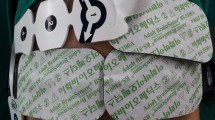Abstract
Purpose
The aim of this study is to show whether peripheral perfusion monitoring methods reflect central perfusion during shoulder arthroscopy at beach chair position. We hypothesized that mean arterial pressure (MAP), central heart rate (CHR) and peripheral oxygenation (SaO2) measurements individually will not parallel cerebral oximetry measurements by near-infrared spectroscopy (NIRS).
Methods
Between 2011 and 2012, 53 patients who had arthroscopic rotator cuff repair surgery in the beach chair position were enrolled prospectively. Median ages of the patients were 58 (range 42–68) years. The regional cerebral oxygen saturation value of each hemisphere was continuously monitored by the use of NIRS. MAP, CHR, SaO2 and both hemispheric cerebral oxygen saturation values were recorded at six time periods peri-operatively. Correlation and differences between parameters were evaluated.
Results
Cerebral oxygen saturation of right hemisphere was dropped >20 % in 28.3 and 45.3 % of the patients. At left hemisphere, cerebral oxygen saturation was dropped >20 % in 20.8 and 43.4 % of the patients. Peripheral saturation values were statistically different from cerebral saturation values (p < 0.001). On the other hand, there was a correlation between cerebral saturation and MAP values (p < 0.05).
Conclusion
Cerebral oximetry by NIRS may prove useful as a monitor for cerebral ischaemia. In the absence of NIRS, CHR can partially detect abnormalities but not trustable, and MAP is the most reliable method for monitoring.
Level of evidence
III.


Similar content being viewed by others
References
Bhatti MT, Enneking FK (2003) Visual loss and ophthalmoplegia after shoulder surgery. Anesth Analg 96:899–902
Casati A, Fanelli G, Pietropaoli P et al (2005) Continuous monitoring of cerebral oxygen saturation in elderly patients undergoing major abdominal surgery minimizes brain exposure to potential hypoxia. Anesth Analg 101:740–747
Casati A, Fanelli G, Pietropaoli P et al (2007) Monitoring cerebral oxygen saturation in elderly patients undergoing general abdominal surgery: a prospective cohort study. Eur J Anaesthesiol 24:59–65
Edmonds HL (2002) Multi-modality neurophysiologic monitoring for cardiac surgery. Heart Surg Forum 5:225–228
Fischer GW, Torrillo TM, Weiner MM, Rosenblatt MA (2009) The use of cerebral oximetry as a monitor of the adequacy of cerebral perfusion in a patient undergoing shoulder surgery in the beach chair position. Pain Pract 9:304–307
Fuchs G, Schwarz G, Kulier A, Litscher G (2000) The influence of positioning on spectroscopic measurements of brain oxygenation. J Neurosurg Anesthesiol 12:75–80
Lee JH, Min KT, Chun YM, Kim EJ, Choi SH (2011) Effects of beach-chair position and induced hypotension on cerebral oxygen saturation in patients undergoing arthroscopic shoulder surgery. Arthroscopy 27(7):889–894
Murkin JM, Adams SJ, Novick RJ et al (2007) Monitoring brain oxygen saturation during coronary bypass surgery: a randomized, prospective study. Anesth Analg 104:51–58
Murphy GS, Szokol JW, Marymont JH et al (2010) Cerebral oxygen desaturation events assessed by near-infrared spectroscopy during shoulder arthroscopy in the beach chair and lateral decubitus positions. Anesth Analg 111:496–505
Papadonikolakis A, Wiesler ER, Olympio MA, Poehling GG (2008) Avoiding catastrophic complications of stroke and death related to shoulder surgery in the sitting position. Arthroscopy 24:481–482
Pohl A, Cullen DJ (2005) Cerebral ischemia during shoulder surgery in the upright position: a case series. J Clin Anesth 17:463–469
Rains DD, Rooke GA, Wahl CJ (2011) Pathomechanisms and complications related to patient positioning and anesthesia during shoulder arthroscopy. Arthroscopy 27(4):532–541
Samra SK, Dy EA, Welch K, Dorje P, Zelenock GB, Stanley JC (2000) Evaluation of a cerebral oximeter as a monitor of cerebral ischemia during carotid endarterectomy. Anesthesiology 93:964–970
Tobias JD (2006) Cerebral oxygenation monitoring: near-infrared spectroscopy. Expert Rev Med Dev 3:235–243
Yao F-SF, Tseng C-CA, Ho C-YA, Levin SK, Illner P (2004) Cerebral oxygen desaturation is associated with early postoperative neuropsychological dysfunction in patients undergoing cardiac surgery. J Cardiothorac Vasc Anesth 18:552–558
Author information
Authors and Affiliations
Corresponding author
Rights and permissions
About this article
Cite this article
Kocaoglu, B., Ozgen, S.U., Toraman, F. et al. Foreseeing the danger in the beach chair position: Are standard measurement methods reliable?. Knee Surg Sports Traumatol Arthrosc 23, 2639–2644 (2015). https://doi.org/10.1007/s00167-014-3090-6
Received:
Accepted:
Published:
Issue Date:
DOI: https://doi.org/10.1007/s00167-014-3090-6




